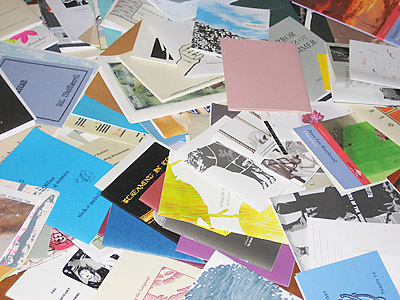
This is not so much a book review as a survey article. Noah Eli Gordon consulted these books:
Hindley, Charles. Curiosities of Street Literature. Welwyn Garden City, Hertfordshire: Seven Dials Press, 1969.
Kaser, David. A Book for a Sixpence. Pittsburgh, PA: Beta Phi Mu, 1980.
Manguel, Alberto. A History of Reading. New York: Penguin Books, 1997.
Shepard, Leslie. The History of Street Literature. Detroit, MI: Singing Tree Press, 1973.
Weiss, Harry B. A Book about Chapbooks. Hatboro, PA: Folklore Associates, Inc., 1969.
This review is about 4 printed pages long, and originally appeared in Rain Taxi, Vol. 11 No. 1, Spring 2006, as an introduction to the ongoing column Chapbook Corner. It is copyright © Noah Eli Gordon and Jacket magazine 2007.
1
My heart is in my
pocket, it is Poems by Pierre Reverdy.
— Frank O’Hara
2
From the 16th to the 19th century, chapbooks flourished as a locus of popular culture, religion, folklore, myth, history, poetry, and story; for many, they were the sole link connecting them to the events of the day, and, implicitly, to a sense of personal identity. Though their popularity occasionally waned over the course of the medium’s long history, chapbooks are experiencing a revival in the contemporary poetry scene. For this reason, Rain Taxi inaugurates an ongoing column dedicated to the poetry chapbook. But first, some history.
3
In the British Isles, the chapbook has its origins in the broadsheet, a single sheet printed on both sides, and the broadside, a sheet with print on one side. Because of the ease with which it could be produced, the broadside was used for the detailing of official notices and proclamations. These sheets were affixed to public places and often read to those passers-by who were illiterate. In the marketplace, the broadside found the height of its popularity in that of the ballad, a rhymed verse whose tune its hawker would sing.
paragraph 4
The ballads encompassed everything from the political news of the day to tales of murder, romance and humorously fanciful flights of the imagination. In Shakespeare’s The Winter’s Tale, Autolycus describes one of his ballads offered for sale as the story sung by a fish. In many ways, the broadside began the codification of oral and folk traditions into a tangible and tactile record.

5
Later, these broadsides and broadsheets, folded into fourths, eighths, or even sixteenths, became what we know of today as chapbooks, small booklets of between eight and 32 pages. As Leslie Shepard writes in The History of Street Literature, “The purchaser would slit the pages and lovingly stitch or pin them — a kind of do-it-yourself paperback.” The number of folds one could make to a single sheet dictated the original page count; although contemporary printing technology renders the need for such a count obsolete, the length of the chapbook, like any other tradition so far removed so as to have little memory of its origins, has more or less remained the same to this day.
6
Although there exists some disagreement in the literature as to specifics of its etymological origin, it is generally agreed that the term chapbook is derived from the figure who made his living peddling them — the chapman. Chapmen had a reputation for being rogues, and like the above-mentioned Autolycus, sometimes doubled as pickpockets in their journeys to and from towns and rural villages. Such journeys found chapmen frequently bedding in barns, fleeing from dogs, and fending off thefts from other road scoundrels. Yet the visit of a chapman to a rural village, though tinged with suspicion, was a welcome occasion, as he provided many with their sole link to the rest of world, both in his wares and his gossip, a kind of Johnny Appleseed of early literary education.
7
From a condensed version of The Canterbury Tales to lewd stories of debauchery, accounts of murder trials and shipwrecks, and transcriptions of speeches and hymns, the contents of early chapbooks were an amalgamation of the literature normally reserved for those able to afford the higher price of “real” books and anything that might entertain enough to turn a profit for the publisher. Chapmen themselves were known to author some of the more worldly tales they offered for sale. Interestingly, there were even chapbooks containing detailed information about roads, fairs, and town maps, intended to assist the traveling chapmen.
8
The chapbook was not confined to the English-speaking world. China, Germany, Spain, Italy, France, the Netherlands and numerous other nations all had their own form of this phenomenon of populist literature. “The contents of chapbooks, the world over,” writes Harry B. Weiss in A Book About Chapbooks, “fall readily into certain classes and many were the borrowings, with of course, adaptations and changes to suit particular countries.” Thus, the chapbook became a vehicle for the worldwide democratizing of folklore, for the melding of myth and imagination across national divides, and, ostensibly, for recognizing the value and power of reading, regardless of class.
9
In England, the eventual decline of the chapbook in the late 19th century had no single cause; rather, it was the culmination of several factors, all arguably after-effects of industrialization: the passage of laws banning hawking and singing in the streets, effectively putting chapmen out of work; new technologies and changes in bookmaking, allowing for the production of more widely affordable books; the rise in popularity of the novel; and the lifting, in 1855, of the newspaper tax, which allowed for the creation of penny dailies and moved newspapers beyond the sphere of the wealthy.
10
Distanced from its historical roots, the form of the chapbook found new life in the burgeoning world of modern poetry, in which pamphlets from the international Dada movement and beautifully designed works of Russian avant-garde poets set a new standard. Continuing through Allen Ginsberg’s Howl and Other Poems, the mimeo revolution of the 60s, the advent of photocopying and desktop publishing, and the production of PDF files containing the online equivalent, the chapbook now thrives in the esoteric though open space of contemporary poetry. From work that is self-published and stapled to studiously letter-pressed and hand-stitched, and whether published in conjunction with a reading series, like those of Belladonna Books in New York City, as part of a subscription service, like the output of Ugly Duckling Presse, or as an offshoot of a larger publishing project, like Sarabande’s Quarternote Chapbooks or even Rain Taxi’s own Brainstorm Series, the chapbook constitutes a crucial nexus of the poetry community.
11
Intriguingly, rather than the democratizing of reading it once heralded, it is now the ease of access to the means of production that defines the chapbook’s unfettering of hierarchy. Yet just as the chapman’s journeys and wares served as a cultural glue, allowing even those in the most rural of districts in on the literature and news of the day, so the chapbook in its current manifestation allows poets to enter into a shared life of the imagination while swerving around the dominant paradigms of economic and social space. Whether comprised of an extended sequence, a series of short poems, or a single, longer work, the chapbook, in its momentary focusing and sculpting of the reader’s attention, is the perfect vehicle for poetry.

Noah Eli Gordon
Noah Eli Gordon is the author of six books, three of which were published this year: Novel Pictorial Noise (Harper Perennial, 2007; selected by John Ashbery for the National Poetry Series), Figures for a Darkroom Voice (Tarpaulin Sky 2007; in collaboration with poet Joshua Marie Wilkinson and artist Noah Saterstrom) and A Fiddle Pulled from the Throat of a Sparrow (New Issues 2007). His reviews and essays have appeared in numerous publications, including: Boston Review, Review of Contemporary Fiction, Poetry Project Newsletter, and the book Burning Interiors: David Shapiro’s Poetry and Poetics. He continues to write a column on chapbooks for Rain Taxi: Review of Books and teaches at the University of Colorado at Denver.
The Internet address of this page is http://jacketmagazine.com/34/gordon-chapbooks.shtml